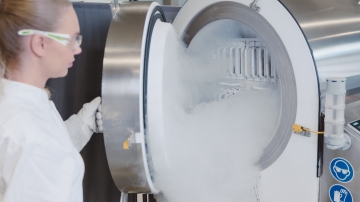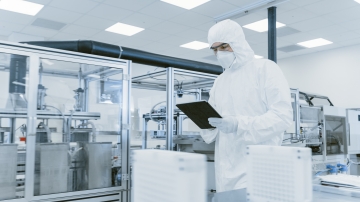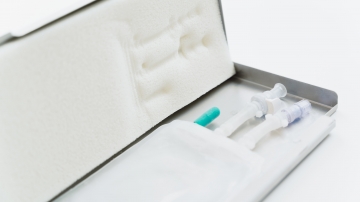Small batch manufacturing & fill-finish in cell and gene therapy
Table of contents
ShowIn these years, we are witnessing the advent of a new era in medicine and pharma. Recent breakthrough advances in life sciences such as immunotherapy, next generation sequencing and cell and gene therapies have sparked an unbelievable acceleration of biotechnology development. The COVID-19 pandemic forced the biotech field to even higher productivity and catalyzed much needed progress in regulatory processes. With the first approvals by the US Food and Drug Administration (FDA) and several hundreds of such advanced therapies in early to late stage clinical trials, there is no slowing down on the horizon.
But this progress is not easy to achieve. Biopharma companies face unprecedented challenges that pertain to the cost of goods, formulation, supply chain and logistics of large-scale commercial production of cell and gene therapies (CGT). With biopharmaceutical drug products becoming more personalized, the supply chain must change from traditional manufacturing to keep an inventory, towards a manufacturing process that commences very close to the actual treatment process. See also the advanced CGT bag filling system.
A great example is the treatment of insidious cancers with chimeric antigen receptor T-cells, in short CAR T-cells, that relies on modifying the patient’s own T-cells to instill them with a targeted way to fight cancer cells. The notion of keeping an inventory of such therapies is absurd, yet the benefits of personalized medicines drive biotech companies to form strong partnerships with contract development and manufacturing organizations (CDMOs) and supply companies to find and optimize innovative ways to solve these challenges.
The difference between cell therapy and gene therapy
What is cell therapy and what is gene therapy? What are the differences?
Cells are small building blocks of organisms that come in many shapes and functions, e.g. liver cells, muscle cells, nervous system cells and skin cells. Genes are regions of DNA molecules inside cells and carry genetic information, much like a blueprint or a program. Every person carries approximately 20 thousand genes and two copies of each that stem from each parent.
If a gene is altered (mutated) at a critical region, this could lead cells to malfunction or perish, ultimately leading to a genetic disease. This might be caused by environmental influences or hereditary.
Gene therapies aim at either silencing destroyed genes or restoring malfunctioning genes by repairing them or replacing them with a working copy.
Cell therapies work through replacing missing cells or altering a class of cells to carry out their normal function. Moreover, some cell therapies rely on modifying cells to carry a therapy into the patient’s body. For cell therapy, cells are first cultivated or modified outside the body in manufacturing facilities and then introduced into the patient through an injection. The cells could be derived from the patient (autologous cells) or from a donor (allogeneic cells). Read more about autolgous vs. allogeneic.
For CAR T-cell therapy, the patient’s own T-cells are harvested and subsequently genetically modified and subjected to validation, before being reintroduced into the body. Therefore, CAR T-cells are autologous cells and both cell therapy and gene therapy.
Hurdles in CGT manufacturing
The manufacturing of cell and gene therapies is a fledgling field that is continuously evolving with developments in bioprocessing, filling, robotics, process development and quality control. The production and logistics in small batches for initial clinical trials is becoming a solved problem but the scale-up to batch sizes suitable for large clinical development trials and ultimately commercialization in accordance to (current) Good Manufacturing Practice (GMP and cGMP) is challenging biotech companies.
A key part of the solution to manufacturing and logistics hurdles is the formation of strong partnerships with companies that are experienced in the development of single-use equipment for batch production filling lines and fill-finish of injectable final products, e.g. biologics. Their experience has direct carryover to emergent novel cell culture and cleanroom methodologies and facilitates innovative solutions for automated systems performing aseptic fill into vials and syringes.
Fluid management of cell and gene therapies – prospering areas of application for SUT
In the wide field of cell and gene therapy (CGT), reliable and safe manufacturing processes are vital. As more and more treatment options are being approved by regulators like FDA or NIH, there is also an increasing need for more flexible and efficient solutions, considering that upscaled production processes can be cost and resource consuming.
This is why single-use technologies are predicted to play an even greater role in CGT manufacturing process in the future than they already do: Turnaround times can be shortened significantly, and both costs, time and resources can be saved by the implementation of SUT-based fluid management solutions.
Fluid management solutions in cell therapies
Cell therapy manufacturing has allowed major breakthroughs throughout life sciences and opened new treatment options of various diseases. For instance, the transplantation of human cells is crucial in oncology, as the insertion of stem cells can be a life-saving procedure in the fight against leukemia and other types of cancer. Yet another field of application is regenerative medicine: Here, success has already been achieved far beyond clinical trials.
Since cell therapies – be it autologous or allogeneic cell therapies – include various steps to be taken ex vivo (including storage of the cell products before its application), it is vital in the healthcare sector to rely on dedicated fluid management solutions that allow for a seamless transition from harvesting a respective type of cell (e.g. from a patient’s bone marrow) and eventually further processing steps up to the final application of the product.
Fluid management systems in gene therapies
Genome sequencing – the decodification of the human genome – has allowed unprecedented insights into the genetic “blueprint” of our bodies, thus also in the origin of many genetic diseases, caused e.g. by mutations, missing or faulty genetic material.
Gene editing techniques like CRISPR/cas9 have been developed to gain influence on the human genome and medical conditions resulting from it. For instance, this is achieved by inserting a new gene into a patient’s genome, e.g. by the means of viral vectors like AAVs (adeno-associated viruses) for gene delivery.
Given the great impact such therapies can have on a patient’s health, fulfilling the requirements of regulators like FDA is vital for both the procedure of gene therapy manufacturing and the involved equipment, which also applies for the fluid management systems in gene therapies, but also in CGT in general. Fill and finish processes need to minimize the risk of contamination, which is why a specialized fill and finish system is advisable to carry out the critical step of aseptic filling into bioprocess containers.
Fluid management solutions in gene-modified cell therapies
Modifying or adding a specific human gene into a cell is a major aspect in gene-modified cell therapies, which play an essential role in the fight against several medical conditions. By the modification of certain immune cells, for example, CAR T cells (chimeric antigen receptor t cells) are produced as a novel approach in the treatment of certain types of lymphoma and other forms of cancer.
By the means of therapeutic genes for CAR T cell therapy, a patient’s immune system can be trained to fight specific target cells – cancer cells. This is how immunotherapy represents a promising approach in the fight of previously incurable diseases.
In order for gene-modified cell therapy to be both effective and secure, standards have to be fulfilled both within every step of a respective procedure and the equipment that is called on. This is why fluid management systems by Single Use Support have been developed to provide safety and efficiency along the respective processing steps.
Challenge accepted
As highlighted in the previous chapters, there is a wide spectrum of medical conditions where cell and gene therapies represent promising treatment options that could not even be dreamt of even a few years ago. Considering the great amount of clinical trials being carried out in this field, CGTs are presumably playing an even more central role in life sciences.
It is only natural that industry needs to adapt to these innovations, and this is where we come in: With RoSS.FILL CGT, Single Use Support developed a fully automated cell and gene therapy filling & draining system for parallel use of small single-use bags at highest accuracy down to few g. It allows the use of 36 single-use bags with volumes from 10 mL to 500 mL, with filling times of down to 20 seconds for 250 mL bags. This system is ideal for studies on the laboratory scale and small volumes in cell and gene therapies or seed train intensification. RoSS.FILL for CGT is fully compatible with the protective shell RoSS.KSET that makes transporting highly valuable goods convenient and secure.

Conclusion
We are experiencing exciting times in medicine and the life science sector. Breakthrough therapeutics are entering the broad market, curing and treating previously devastating diseases. The key players face big challenges in the commercial manufacturing of cell and gene therapy products but forming collaborations with strong partners in the field of drug substance logistics will solve many issues that accompany the accelerating speed of CGT commercialization. Single Use Support is excited to contribute to these developments.
FAQs
What are the benefits of single-use fluid management systems in CGT?
Single-use fluid management systems bring a wide array of advantages for Cell and Gene Therapy (CGT), including:
- high reliability
- cost and resource efficiency
- flexibility and customizability
- shortened turnaround times
What kinds of diseases do gene and cell therapy treat?
CGT is most commonly used in the therapy of various cancer types, but also of genetic diseases and certain infections.
Do mRNA vaccines make part of gene therapy?
Vaccines based on RNA are not considered to be a gene therapy, since the human genome is not modified when a patient receives an mRNA vaccine.
Instead, mRNA vaccines usually present RNA of a biological entity to a person’s immune system, which is then trained to recognize and fight it. That way, the immune system is supposed to be prepared when it encounters the actual biological entity.
What industries are focused on cell and gene therapy?
Cell and Gene therapy (CGT) make part of several disciplines in life sciences and are an important field of concern for the biopharma industry.









